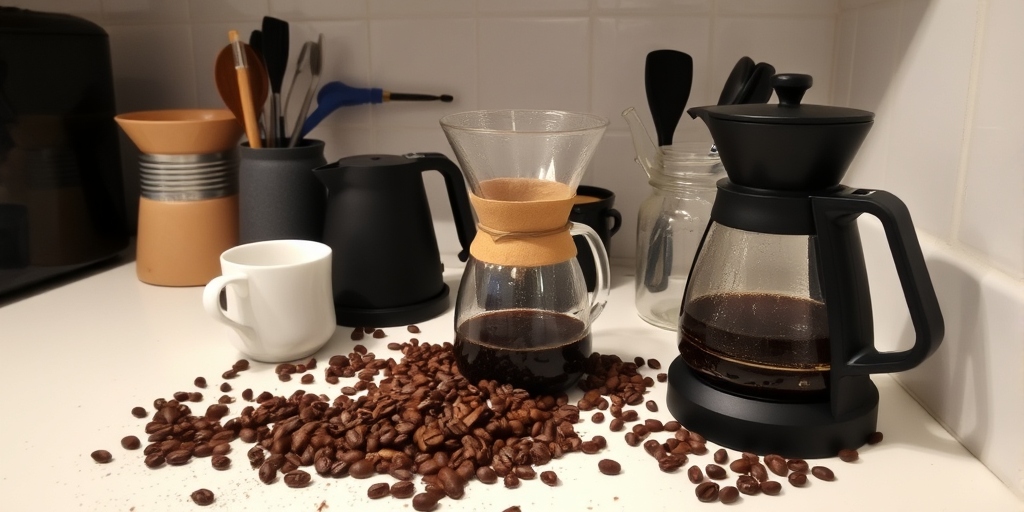Have we ever wondered why our carefully brewed coffee sometimes misses the mark? In our journey to perfect every cup, we’ve uncovered common brewing errors that dramatically alter flavor and extraction quality. In this post, we delve into the top mistakes people make with coffee—from stale beans to imprecise water ratios—and reveal how a few actionable tweaks can transform your daily ritual. Join us as we explore these pitfalls and share expert strategies to elevate your brew to its full potential.
Addressing Common Technique Flaws: How to Fix Coffee Brewing Errors
We have observed that small technical deviations, such as an imprecise tamping pressure or inconsistent dosing measurements, can dramatically undermine our brewing outcomes. Our experience indicates that recalibrating dosing tools and adjusting tamping pressure are critical steps in eliminating extraction errors. Even slight variations during tamping can lead to channeling and under-extraction, compromising the flavor balance of our brew. By embracing a meticulous approach to every brewing parameter, we reinforce our commitment to precision and quality in every cup.
Implementing corrective measures is essential for transforming a flawed extraction into a consistently excellent brew. We advocate for regular equipment maintenance and the use of calibrated tools to ensure that each variable—from grind size to water temperature—is controlled. Expert insights underscore that even minor misalignments in dosing or tamp pressure can disrupt the extraction process. Following these practical guidelines not only improves brew consistency but also aligns with our drive for excellence and exactitude in every cup produced.
- Measure coffee accurately using calibrated tools.
- Adjust tamping pressure to avoid channeling.
- Clean and maintain your brewing equipment regularly.
- Reassess water temperature and extraction time.
Troubleshooting Coffee Pitfalls: Expert Tips to Fix Your Brew

We encounter issues in our extraction process when brewing times are miscalculated or the grind uniformity is off. Precision in every step of our brewing routine is critical. We have found that frequent equipment calibration and strict attention to water quality—including its mineral content and proper filtration—are instrumental in diagnosing these pitfalls. By reviewing critical factors such as grind consistency and brew timing, we can directly link specific errors to straightforward fixes. Once we identify issues like channeling or ineffective dosing, we recalibrate our process, ensuring each variable is controlled. When a reader asks, “What causes over-extraction?” the answer is concise: too long a brewing time, remedied by simply reducing the brew duration to suit the grind. Elaborating, this swift correction optimizes flavor extraction quickly and efficiently.
Routine equipment checks and adherence to precise brewing practices are the cornerstones of our troubleshooting approach. We tackle common errors by regularly inspecting the functionality of our espresso machines and ensuring that tamping, dosing, and water temperature remain within ideal ranges. As we refine our process, practical measures like these help us prevent recurring mistakes, elevating our brew quality consistently. Our strategy is to question every deviation and address each anomaly with targeted interventions, transforming an initially flawed brew into a consistent, exceptional cup.
| Mistake | Likely Cause | Fix Applied |
|---|---|---|
| Over-extraction | Too long brewing time | Reduce brew time |
| Under-extraction | Inadequate grind size | Adjust grind setting |
| Bitter flavor | Incorrect water-to-coffee ratio | Recalibrate measurement |
| Weak coffee | Stale beans | Always use fresh beans |
Final Words
In the action, we examined essential coffee flaws and correct methods to improve bean freshness, dosing, and extraction balance.
We dissected each step of brewing—from pinpointing even the smallest error to applying corrective strategies.
Our guide detailed The Top Mistakes People Make with Coffee (and How to Fix Them), offering actionable insights on water ratios, grind consistency, and proper technique.
Together, we uncovered refined methods that empower us to elevate every cup, ensuring excellence and a positive, robust coffee journey.
FAQ
What are the most common coffee brewing mistakes?
A: The top coffee brewing mistakes include using stale beans (over 30 days old), incorrect water-to-bean ratios, inconsistent grind sizes, improper dosing, and incorrect brewing times.
How do I know if my coffee is over-extracted?
A: Over-extracted coffee typically tastes bitter and harsh. This occurs when brewing time is too long or the grind is too fine, leading to excessive compound extraction.
What’s the ideal water temperature for brewing coffee?
A: We maintain water temperature between 93 to 97 degrees Celsius (199-207°F) for optimal extraction. Adjust slightly lower for dark roasts and higher for light roasts.
How important is the water-to-coffee ratio?
A: The ideal water-to-coffee ratio is 2:1 for balanced extraction. Using incorrect ratios, like 3:1, results in weak or bitter coffee and compromises the final flavor.
How often should I clean my coffee equipment?
A: We recommend cleaning coffee equipment after each use and performing deep cleaning weekly. Regular maintenance prevents flavor contamination and ensures optimal extraction.
Why does my coffee taste weak?
A: Weak coffee usually results from using stale beans, incorrect dosing measurements, or improper water-to-coffee ratios. Using fresh beans and calibrated measurements ensures full flavor.
What’s the proper way to store coffee beans?
A: Store coffee beans in an airtight container away from light, heat, and moisture. Use within 30 days of roasting to maintain optimal flavor and freshness.
How can I ensure consistent coffee quality?
A: Maintain consistent quality by measuring precisely, using calibrated tools, keeping equipment clean, and monitoring water temperature and extraction time.

